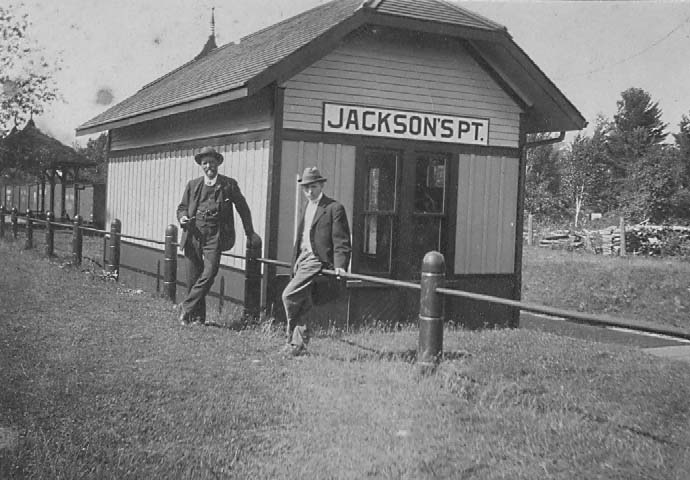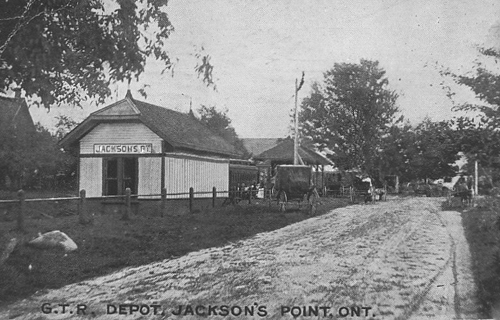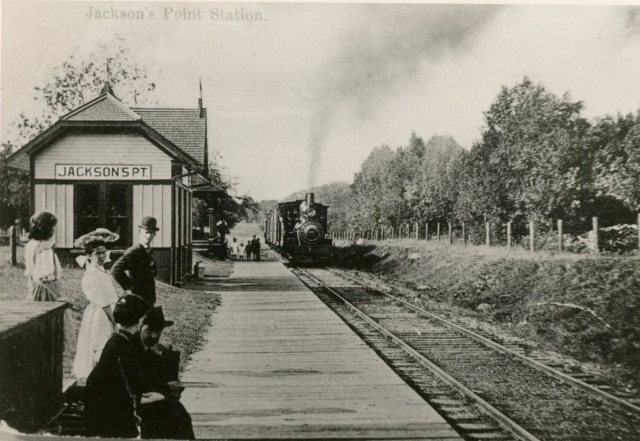Summary
Jackson’s Point Station was built in 1877 by the narrow-gauge Lake Simcoe Junction Railway as its northern terminus. While the railway was formed independently, it was leased by the Toronto & Nipissing Railway who connected to the LSJR at Stouffville. The first train arrived in Jackson’s Point on October 1st, 1877, and the Lake Simcoe Junction Railway was amalgamated with the Toronto & Nipissing in 1879. The station in Jackson’ Point was a small board-and-batten shelter with minimal facilities inside, located on the east side of Lorne Street just north of Lake Drive. Just north of the station was a wharf that would serve one of two roles depending on the time of year. It brought wealthy passengers to steamships on Lake Simcoe during the summer months, and during the winter it was used for the transport of ice for food preservation. This would eventually fall out of fashion with the invention of the first home refrigerator in 1913. The arrival of the railway transformed Jackson’s Point from a farming community to a waterfront destination for tourists as large retreats and summer homes were built nearby.
The widespread adoption of 4′ 8.5” standard gauge along with competing lines in the area made the Toronto & Nipissing’s operations unprofitable, and it sought to merge with the Midland Railway of Canada. As negotiations were ongoing in 1881, the Midland Railway financed the completion of a third rail to support standard gauge trains. It was officially merged into the Midland Railway on April 1st, 1882, but this arrangement would only last for a short time as the larger Grand Trunk Railway leased the Midland Railway on January 1st, 1884. Despite the popularity of Jackson’s Point as a destination, the railway was never particularly profitable and any substantial amount of train traffic would have existed for only a short time. By 1899, the station at Jackson’s Point had just one inbound and one outbound passenger train per day. The railway faced stiff competition once the Toronto & York Radial Railway opened to Jackson’s Point in 1907, as they were able to provide a faster service than the Grand Trunk did. While the Grand Trunk’s service to Jackson’s Point had rebounded to six passenger trains per day by that point in time, it would rapidly decline to zero by 1917. The Grand Trunk itself would simultaneously undergo financial difficulties, culminating in its nationalization and subsequent merger into Canadian National in 1923. Freight service continued but was significantly impacted by the closure of the wharf in September 1927. The line between Jackson’s Point and Sutton was officially abandoned in 1929 and the rails were torn up shortly thereafter. The railway south of Sutton was abandoned much later and much of it was readapted into the Sutton-Zephyr Rail Trail, while the section north of Sutton was abandoned too early to benefit from the rail banking initiatives of the late 20th century. The former station property is now occupied by Lorne Park and much of Grew Boulevard follows the railway right-of-way.
Condensed Station Info:
| Location: | Served By: | Current State: | Date Built: | Date Demolished: |
| Lake Ddrive and Thompson Drive | T&N (1877 – 1882) MRC (1882 – 1884) GTR (1884 – 1917) | Demolished | 1877 | 1929 |




